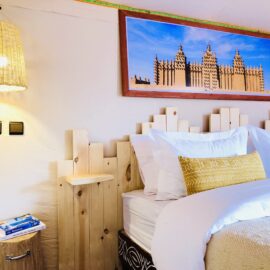Indigo or the magical blue.
The dye is extracted from the leaves of plants in the genus Indigo era, which grow in tropical climates.
Dyers made dye by crushing the plant leaves and fermenting them in water.
This turns the compound indican, which is a colorless amino acid, into indigotin, a blue dye. The fermented leaves are then mixed with lye, pressed into cakes, dried, and finally powdered.
The History of Indigo Dyeing date to more than 6000 years ago. Originally from India, then was split to the world by the trading routes to North Africa and trans-Saharan.
The Tuaregs have been called the “blue people” for the indigo dye coloured clothes they traditionally wear and which stains their skin to protect themselves from the scorching sun and some deadly insects while they were traveling in the desert.
From the Tuareg nomads of the Sahara to the grassland kingdoms of Cameroon, Indigo cloth signified wealth, abundance and fertility. A century ago blue and white striped cloth was the normal attire across a vast area of the Sahel, while numerous traditions of “shibori” type resist pattern dyeing flourished.
Indigo dye was also used by the Tuareg to protect against the scorching sun and some deadly insects while they were traveling in the desert.
In order to preserve such social and human values, we chose this name for one of the tents in the camp.
Pricing Plans
Regular plan
| Sun | Mon | Tue | Wed | Thu | Fri | Sat |
|---|---|---|---|---|---|---|
| $0.0 | $0.0 | $0.0 | $0.0 | $0.0 | $0.0 | $0.0 |

